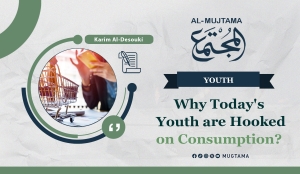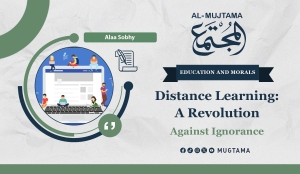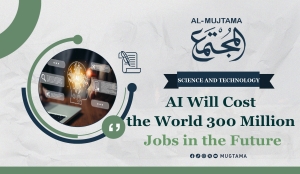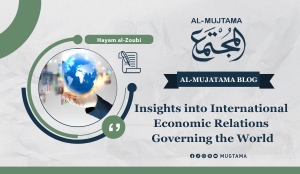Why Today's Youth are Hooked on Consumption?
February 11, 2025
In an era where technology is rapidly advancing, and globalization is intertwining various aspects of life, social media platforms have emerged as key players in shaping behaviors and consumer preferences globally, especially among the youth. Over time, these platforms have evolved from mere tools for communication and entertainment to powerful instruments of influence and marketing, significantly reinforcing consumer culture among individuals in their twenties and thirties.
Social media plays a crucial role in shaping the behaviors and consumer tendencies of today's youth. According to a study conducted by eMarketer (a company specializing in internet market research) in 2023, 85% of young people use social media on a daily basis.
Furthermore, a report by Statista, a company specializing in market and consumer data, indicated that the number of social media users worldwide exceeded 3.8 billion in 2021. This has made social media a primary driver of youth behavior and has facilitated easy access to user opinions and experiences with various products and services.
This influence affects purchasing decisions and contributes to the spread of consumer culture, as social media increasingly impacts youth desires and tendencies, encouraging their consumer inclinations through advertisements and content related to products and brands.
Social Pressure
In response to this, young people are greatly influenced by these desires, often resorting to purchasing and consuming even when they have no real need, driven by the social pressure exerted by social media, which places external appearances as a top priority.
In this context, recent statistics indicate that a significant portion of consumers—around 54%—are influenced by social media content in their purchasing decisions, according to a report issued by the Pew Research Center in 2021.
Additionally, a study conducted by Nielsen (a market research company) in 2020 revealed that 49% of consumers trust recommendations they receive through social media platforms. This aligns with a report from eMarketer, which noted that the number of social media users worldwide reached 4.33 billion in 2023, with 54% of them using these platforms to search for new products and services.
The same report highlighted that young people are the most affected age group by advertisements on social media, emphasizing the psychological and intellectual influence on this particular demographic globally, especially in the Arab world.
Advertising products and services through social media is one of the most impactful forms of advertising on youth globally. This is reflected in the average amount of time they spend on these platforms, which is 3.7 hours per day, according to Hootsuite (a company specializing in social media management).
Arab Youth
The situation is no less impactful than its global counterpart. A study conducted by the Gulf Research Institute in 2022 revealed that 60% of Arab youth consider social media a primary source of information about products and services.
Additionally, a study conducted by Umm Al-Qura University in Saudi Arabia in 2021 found that 70% of young people rely on social media for research and consultation before making purchases.
“Influencers” are one of the main factors contributing to this significant influence of social media on the youth. They possess the ability to change consumer preferences and guide them toward specific products.
Hootsuite reported that 73% of influencers are effective marketing tools for brands, and product manufacturers already utilize them for promotional purposes.
Targeted advertising for various youth segments plays a significant role in reinforcing consumer culture, as companies use big data to direct advertisements precisely to the appropriate audience.
In this regard, a study published by Forbes magazine in 2021 indicated that 67% of users feel that advertisements on social media influence their purchasing choices.
With the increasing reliance on online shopping, a survey conducted by The Economist in 2022 found that 85% of consumers prefer to shop online after seeing products on social media.
Of course, this influence does not come without its negative aspects. A study published by the Journal of Social Sciences in 2023 found that excessive exposure to advertisements and marketing content can lead to “increased social pressure” to possess the latest goods and services. This contributes to excessive consumer culture that often surpasses individuals' actual needs.
Consequently, social media has become a “facilitator” for addiction that is no less dangerous than drug addiction, whether in terms of psychological or financial impact, according to the aforementioned studies.
Thus, there is an urgent need to raise consumer awareness, particularly among the youth, and encourage them to adopt conscious and responsible consumption. Achieving this can only be accomplished by instilling “non-material” values in their hearts and minds and challenging the culture of appearances reinforced by social media.
-------------------------------------------------------------
Distance Learning: A Revolution Against Ignorance
February 08, 2025The world anticipates new breakthroughs resulting from the accelerated pace of distance learning, with an increasing reliance on modern communication technologies and the internet to provide education anytime and anywhere, gaining new knowledge spaces in what resembles a new invasion of ignorance and darkness.
The history of the development of distance learning dates back more than two hundred years, specifically in 1729, when American educator Caleb Phillips began offering weekly lessons through the Boston Gazette newspaper.
In 1874, the University of Illinois launched the first curriculum system for correspondence education. Later, the radio was used for this purpose in 1922 when the University of Pennsylvania began offering several courses via radio.
Through television, Stanford University initiated a program in 1968 to offer courses to engineering students via a television channel.
A Click Takes the Student to School and University
The interest in distance learning escalated with the emergence of the internet. In 1985, the first online postgraduate programs were broadcast.
With the dawn of the new millennium, interest in distance learning grew, and it became a major complement to school and academic education.
Statistics indicate that the e-learning market exceeded $315 billion in 2021 and is expected to reach $457.8 billion globally by 2026.
A Better Future
Distance learning will continue to evolve and transform in the future, with modern and innovative technologies providing new opportunities to improve its quality and enhance accessibility worldwide, according to Dr. Hassan Makawi, former Dean of the Faculty of Mass Communication at Cairo University. He added that distance learning managed to overcome the repercussions of epidemics, such as the coronavirus outbreak.
Dr. Makawi told Al-Mujtama that modern technologies have enabled unprecedented possibilities for interaction and communication between teachers and learners, pointing to the potential of blending direct learning with distance learning.
Free Internet Will Open More Doors of Knowledge
Dr. Makawi stressed the importance of familiarizing students with modern technologies and providing them with all possible resources, such as the internet, tablets, and devices for distance learning, to address the problem of overcrowded classrooms faced by poor countries.
However, Dr. Makawi hinted at the negative impacts of distance learning, such as students experiencing isolation and possibly disconnecting from society. He emphasized that face-to-face learning remains the best option, as it allows for instant and natural interaction without any difficulties.
Investing in Technology
Meanwhile, Abdel Hafiz Tayel, Director of the Egyptian Center for the Right to Education, believes that books remain indispensable and are the best educational tool, which cannot be replaced. Distance learning, he said, complements books and serves as an additional tool.
Tayel added that technology is a tool in the hands of students or teachers, enabling them to access information in diverse, faster, and better ways than traditional methods. Nonetheless, he noted that studies indicate that some countries focus on distance learning only at the university level, neglecting its earlier stages.
He continued by stressing the need for a robust infrastructure and strong internet connectivity to maximize the available tools, in addition to opening up information sources to students.
Distance Learning Successfully Overcame the Coronavirus Pandemic
Modern Platforms
On his part, teacher Gamal Al-Tawil, a mathematics supervisor in one of Egypt's governorates, highlighted the capacity of modern educational technologies to open new horizons capable of transforming the world’s future.
He pointed out that education evolved from traditional display devices to electronic whiteboards, smartboards, tablets, and numerous distance learning programs, which played a significant role in overcoming the challenges posed by the coronavirus pandemic.
Al-Tawil explained that there are many educational platforms available online, offering a wide variety of educational and training courses. Among them is the LMS platform, which some Arab countries have established as a comprehensive guide for students, teachers, and parents, making learning enjoyable and empowering students to visualize their lessons.
He concluded by saying: From here, we can reach the farthest point, as there are no longer barriers to learning, especially with digital transformation and the technological advancements the world is witnessing in the field of information technology.
-------------------------------------------------------------
AI Will Cost the World 300 Million Jobs in the Future
January 29, 2025A report issued by the investment bank Goldman Sachs stated that artificial intelligence could replace the equivalent of 300 million full-time jobs in the coming period.
According to the report, AI technologies will take over a quarter of jobs in the United States and Europe, but this could also mean new job opportunities and a boost in productivity.
Ultimately, this may lead to a 7% increase in the total annual value of goods and services produced globally. The report states that artificial intelligence, which can generate content remarkably similar to that produced by humans, represents a "major advancement."
The government is keen to encourage investment in AI in Britain, which it says "will ultimately increase productivity across the economy," and it has sought to reassure the public about its impact.
Technology Minister Michelle Donelan told the British newspaper The Sun, "We want to ensure that AI complements the way we work in Britain rather than disrupts it, creating better jobs rather than eliminating employees."
The report indicates that the impact of AI will vary across different sectors, as it could be used to accomplish 46% of administrative tasks and 44% of legal professions, but these percentages will decline in the construction sector to just 6% and 4% in maintenance.
The BBC News previously reported that some artists are concerned that AI-generated images could harm their future employment prospects.
Carl Benedikt Frey, Director of the Future of Work at Oxford Martin School, University of Oxford, told BBC News, "The only thing I am certain of is that there is no way to know how many jobs will be replaced by AI."
He added, "What ChatGPT does, for example, is allow more people with moderate writing skills to produce articles and written content."
Journalists will face more competition due to "ChatGPT," which may lead to lower wages.
Frey warned that journalists will face increased competition, potentially resulting in lower wages unless there is a significant increase in demand for such work.
He said, "Considering the introduction of GPS technology and platforms like Uber, suddenly, knowing all the streets of London became far less valuable, leading to significant wage cuts of up to 10% for existing drivers, according to our research. The result was lower wages rather than a reduction in the number of drivers."
He emphasized that in the coming years, "generative AI is likely to have similar effects on a broader range of creative tasks."
According to research cited in the report, 60% of workers are employed in occupations that did not exist in 1940.
However, other research suggests that technological change since the 1980s has displaced workers at a faster rate than it has created new job opportunities.
The report concluded that if AI follows the pattern of previous IT advancements, it could lead to reduced employment in the short term.
But Torsten Bell, CEO of the Resolution Foundation, told BBC News that the long-term impact of AI remains largely uncertain despite this, "so all definitive predictions should be taken with caution."
He added, "We do not know how technology will evolve or how companies will integrate it into their operations."
He stressed that this does not mean AI will not disrupt the way we work, but we should also focus on potential improvements in living standards due to higher productivity and lower service costs, "in addition to the risk of falling behind if other companies and economies adapt better to technological change."
-------------------------------------------------------------
Digital Threats to Marital Harmony
January 24, 2025
In the era of digital technology, it is impossible to ignore the profound impact of modern innovations on all aspects of our lives, particularly the social ones. One of the most significant changes witnessed in recent years has been the effect of “digitalization” on marital relationships.
The virtual world, made possible by communication technology and social networks, has provided us with extraordinary communication tools. However, it has also introduced new challenges threatening to undermine marital bonds, the strongest human connection described by Allah in the Quran as a “solemn covenant.”
These tools, despite their apparent benefits, can act as a double-edged sword, requiring a deep understanding and effective strategies to preserve family cohesion in the Arab and Islamic world.
The globalization of digitalization presents a unique challenge in this regard, as the influence of the virtual world transcends national, ethnic, and cultural boundaries. Consequently, “online infidelity” has become a global phenomenon.
Social Media
Social media platforms are among the most prominent tools of this globalization, negatively affecting marital relationships. According to a study conducted by Stanford University researcher Katherine Humphreys in 2022, excessive use of social media increases levels of suspicion and distrust between spouses.
The study noted that 40% of couples who use social media excessively face trust issues, with feelings of jealousy arising from their partners' interactions with others. Another study conducted by the Pew Research Center in 2021 revealed that 34% of couples believe social media increases the likelihood of infidelity and negatively impacts their daily communication.
The study also indicated that excessive use of these platforms contributes to marital tensions, ultimately leading to higher divorce rates.
With the growing reliance on text messages and instant messaging applications like WhatsApp and Telegram, these apps have become arenas for communication problems between spouses.
According to another study by Dr. Emily Roberts of Harvard University in 2021, couples who excessively depend on text messaging for daily communication face difficulties in face-to-face communication. The study pointed out that text messages often lack the emotional expression necessary for effective communication, leading to misunderstandings and misinterpretations of intent.
Online Gaming
Online gaming and virtual worlds like “Second Life” have become an integral part of many couples' lives. However, a 2020 study by Dr. James Patterson from the University of California indicated that excessive engagement in these virtual worlds could lead to “marital isolation.”
The same study found that 35% of gamers who spend more than four hours daily playing online games experience deterioration in their marital relationships due to a lack of time and direct communication with their spouses.
The first step to addressing the impact of the virtual world on marital relationships lies in enhancing trust and communication between spouses in the real world. This can be achieved by spending quality time together away from digital devices.
In this regard, a 2023 study by Dr. John Williams at Yale University recommended that couples set aside daily time for face-to-face conversations. This practice reduces stress and doubts while fostering emotional bonding.
Another study conducted by Dr. Lisa Anderson at Oxford University in 2020 suggested that couples engage in shared recreational activities such as sports or artistic hobbies. These activities strengthen emotional connections and mitigate the isolation imposed by technology on their lives.
Digital Boundaries
Establishing clear boundaries for digital use is an effective strategy to address the encroachment of the virtual world on real-world relationships. According to Dr. Sarah Miller in a 2021 study at the University of Michigan, couples who agree on clear boundaries for the use of social media and electronic devices achieve a better balance between their digital and personal lives.
The same study recommended setting specific times during the day free from devices, such as meal times and bedtime.
Similarly, a 2022 study by a research team at the University of British Columbia found that couples who establish clear rules regarding technology use enjoy more satisfying and stable relationships. The study also noted that allocating time for digital devices and family activities can help reduce tensions caused by excessive technology use.
In some cases, seeking marital counseling may be necessary. A 2022 study by Dr. Mark Taylor at Columbia University found that couples who seek marriage counseling can develop effective strategies to cope with the pressures of the virtual world.
Taylor added that counseling sessions help couples better understand each other's needs and develop healthy communication skills.
While the virtual world offers immense benefits, it also poses significant challenges to marital relationships. Understanding these challenges and developing effective strategies to address them is key to maintaining family cohesion and strengthening marital bonds in this digital age.
-------------------------------------------------------------
Insights into International Economic Relations Governing the World
January 02, 2025International economic relations represent the connection between two parties, each belonging to a different political entity. This connection arises within the realm of international and global economic interaction and exchange in the form of agreements. The involved parties work to implement the obligations and conditions stipulated in these agreements.
These relations are governed by several interconnected forces and influences, some related to economic systems and policies, while others pertain to cultural, technological, and geographical factors. These forces can be classified as follows:
First: Economic Forces
These are manifested in several aspects, most notably capitalism, which is the globally dominant system characterized by free markets, competition, and profit as drivers of economic activity. Supply and demand forces determine the prices of goods and services and direct resources.
Another significant force is economic globalization, characterized by interconnected international markets, increased trade, and investments between nations. Global economic organizations such as the World Trade Organization (WTO) and the International Monetary Fund (IMF) play a significant role in controlling international economic relations.
Additionally, emerging economies like China, India, and Brazil are influential forces capable of shifting traditional power balances. Economic blocs such as the European Union and free trade agreements also enhance cooperation among nations and impact international economic relations.
Second: Political Forces
These are represented by major powers with significant political and economic influence, such as the United States, China, and Russia, which have the ability to shape global trade and investment policies. Geopolitical conflicts also affect the flow of resources and trade relations.
National policies are another political force, as governments establish taxes, tariffs, and monetary and fiscal policies that influence international trade. Economic sanctions are often used as political tools to influence other nations' policies, thereby affecting economic relations.
Third: Technological Forces
These are embodied in the digital revolution. Technological advancements and the emergence of the digital economy have made data and information among the most valuable economic resources. Artificial intelligence and automation have significantly altered the nature of work and production.
Innovation and industrial advancements in various fields, such as clean energy, space exploration, and communication technologies, drive transformations in the global economy.
Fourth: Social and Cultural Forces
These include consumer values, as consumption patterns are shaped by cultural and social factors, influencing production and trade. Migration, education, and changes in the nature of required skills also impact the global economy. The disparity between the Global North and South, evident since the 1940s, highlights a clear division: 20% of the world’s population resides in the North (industrialized nations), while 80% are in the South (developing nations).
The distribution of resources, however, is the opposite: 80% are in industrialized countries and 20% in developing ones. International trade in industrialized countries accounts for over 80%, while the South contributes less than 20%. Similarly, 85% of global production comes from the North, compared to 15% from the South. Multinational companies’ investment revenues are 90% from the North and 10% from the South. Global liquidity and its instruments are distributed at 96% in the North and 4% in the South. The natural population growth rate is 1% in industrial nations and 3.5% in developing countries, with this disparity carrying political implications. This division shapes trade flows, aid, and investment, underscoring the imbalance between the North and South.
Fifth: Environmental and Geographical Forces
Regarding natural resources, the distribution of resources such as oil, minerals, and water significantly impacts the structure of economic relations. Climate change also affects food and energy production, increasing the costs associated with natural disasters.
Sixth: Institutional and Regulatory Forces
These are represented by international organizations such as the International Monetary Fund (IMF), the World Bank, and the World Trade Organization (WTO), which set global economic rules. Multinational corporations also play a pivotal role in shaping cross-border trade, investment, and production.
Seventh: Financial Forces
The global banking system influences monetary policies and exchange rates through central banks, such as the U.S. Federal Reserve. Additionally, financial forces include capital and investments, as the flow of foreign direct investment (FDI) and portfolio investments play a crucial role in shaping economic relations between nations.
Thus, international economic relations are governed by the complex interplay of economic, political, technological, cultural, environmental, and financial forces.
Eighth: The Role of Self-Interest
On the other hand, we see that the logic of self-interest can dominate other forces. Self-interest has overshadowed the principles governing international economic relations and is considered one of the pivotal forces. Achieving self-interest in the capitalist system is regarded as a fundamental driver of economic behavior. Individuals and companies make decisions based on maximizing benefits at the lowest cost, whether in trade, production, or investment. Conversely, mutual interest is reflected in avenues of cooperation between countries and companies in trade or the utilization of shared resources.
Additionally, countries' economic policies are formulated to achieve national interests, such as protecting local industries or securing strategic resources. Trade disputes or economic sanctions often arise due to clashes of national interests.
Examples of the impact of self-interest on economic relations include trade agreements based on mutual benefit, such as exporting surplus goods. Conflicts over oil, gas, and minerals demonstrate how nations strive to secure their interests in controlling resources. Economic alliances are built on shared economic interests. Recently, competition between nations and companies to achieve technological superiority has emerged to serve their interests, whether in the digital economy or advanced industries.
Ninth: Norms Governing the International Sphere
These are social and behavioral rules or laws that regulate relations between nations according to the logic of power and interests. These principles are based on human nature and societal dynamics, significantly reflecting on the international system.
The Norm of Predominance
The concept of predominance refers to competition and conflict over dominance and control among international powers. It is also referred to as rivalry (the attempt to win by overpowering). It reflects an adaptation or application of a human societal principle ("the world belongs to the strongest"). Human nature tends toward the pursuit of power and superiority, making international relations often a battleground for competition over resources, influence, and status.
Examples of predominance include conflicts between great powers, such as the Cold War between the United States and the Soviet Union, and today’s economic and technological competition between China and the United States. The outcomes of these struggles include the balance of power, the dominance of one state or alliance on the international stage, and the emergence of alliances or armed conflicts.
The Norm of Resistance
This refers to positive or negative struggles among different powers to prevent the domination of one party and to maintain balance. Resistance ensures balance and prevents international tyranny or despotism. In politics, it is evident in alliances for representation and solidarity, while economically, it appears in blocs. When needed, societies ally with others to consolidate power, but parties may leave alliances if their interests dictate doing so.
Notable examples of resistance include the formation of defensive alliances like NATO to counter Soviet influence and the resistance of smaller states to major powers' interventions through diplomatic or popular means. The outcomes include continued conflicts, whether peaceful or violent, achieving a balance of power, and reducing the likelihood of one-party domination.
The Norm of Reciprocity
This norm reflects responding to a state's actions in a similar manner, whether positive or negative. It represents the highest and most refined level in international relations, contributing to justice and ensuring deterrence without exceeding boundaries.
Examples of reciprocity include economic sanctions between nations (such as mutual sanctions between Russia and the West) and mutual responses in trade or diplomatic relations (e.g., expulsion of diplomats). The outcomes may range from escalation or de-escalation, depending on the circumstances, to maintaining a level of ethical and political balance.
Interaction of Norms in the International Sphere
The interplay between the norms of predominance and resistance is evident. While predominance seeks control, resistance aims to counter this control. Similarly, reciprocity and predominance overlap, as reciprocity can serve as a tool for weaker nations to deter, thereby limiting absolute predominance.
Tenth: Reflection of Predominance, Resistance, and Reciprocity in Economic and Political Relations
Economic Relations:
- Predominance: Appears in the race to control natural resources or markets.
- Resistance: Manifested in protective policies or regulation of international trade.
- Reciprocity: Seen in tariffs and sanctions.
Political Relations:
- Predominance: Evident in regional conflicts or attempts to dominate international organizations.
- Resistance: Seen in forming defensive alliances or resisting foreign influence.
- Reciprocity: Reflected in diplomatic responses and mutual policies.
These three principles represent the foundational rules governing international relations, derived from human nature and societal dynamics. Understanding these principles helps explain international interactions and develop balanced policies to achieve stability and justice in the global order.
-------------------------------------------------------------
-Head of the Department of Economics and Islamic Banking, Assistant Professor at the College of Economics and Business Administration at the Islamic University of Minnesota.







